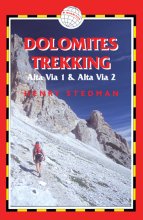These Trailblazer guides … are a godsend for independent travelers.
— Travel & Leisure

Dolomites Trekking
Excerpt:
With a group or independently?
Contents | Introduction | Route options and when to go | With a group or independently? | Sample route guide | Minimum impact trekking

Independent trekking
Camping . . . ?
Few people bother to camp in the Dolomites and there are good reasons for this. Camping can be a very lonely experience, especially outside the high season, and it is illegal in Italy's national parks, which together cover a wide area in the Dolomites. Furthermore, as accommodation in the region's numerous rifugi (mountain huts, see below) is pretty cheap, many trekkers consider a tent or bivouac an unnecessary burden to lug up and
down mountains. Instead, most trekkers prefer to plan their itinerary to begin and end at rifugi, foregoing the need to stay overnight in towns.
That said, there are those who love the freedom of carrying their own shelter around with them. There are also those who swear by camping gear for safety reasons and they have a point: should you find yourself stuck on a mountainside overnight, you'll consider the effort expended in carrying your camping equipment with you all the time to be a small price to pay. Furthermore, in some towns such as Cortina, camping is the only cheap accommodation option – and the campsites in these towns are often superb, with excellent facilities and good restaurants to boot!
. . . or rifugi?
All the main trails in the Dolomites are well served by rifugi. These are mountain huts offering both food and accommodation at very reasonable prices. The advantages are obvious: cheap, warm, sociable, and with all the latest information about the nearby trails, rifugi also allow trekkers to cut down on the amount of gear they need to carry with them. Of course, there are disadvantages too – the loss of freedom engendered by the necessity to reach a rifugio or town before nightfall, the lack of privacy, the high probability that for at least one night you'll have to share a dormitory with a heavy snorer and so on.
Nevertheless, most trekkers feel these are outweighed by the advantages listed above. As a result, this book caters more for those who don't have any camping gear by starting and finishing each stage at a rifugio or a town.
Group/guided walks
The Scuola di Alpinismo, which has offices in Cortina and most other large towns, organizes a variety of short guided treks in the mountains. Unsurprisingly, with their excellent safety record and unparalleled experience in the Dolomites, they are the best people to sign up with should you decide not to do your trek independently.
There are a variety of programmes available organized by the Scuola di Alpinismo in conjunction with the Club Alpino Italiano (CAI). For the beginner, there is an introductory course to the Dolomites, giving advice on where to go, how to climb safely and how best to use equipment. Prices start at £130, with a £30 discount for students and children. Unfortunately, in the high season, and particularly August, they are often booked out months in advance, so do plan and book well ahead. Details of their latest programme and other, more advanced courses, can be found at: www.scuolaaltolario.it. The address of the Cortina branch is: Guide Alpine Scuola D'Alpinismo (email segretaria@caicortina.org), Corso Italia 69a, 32043.
Dolomites Trekking
Excerpts:
- Contents
- Introduction
- Route options and when to go
- With a group or independently?
- Sample route guide
- Minimum impact trekking
Latest tweets